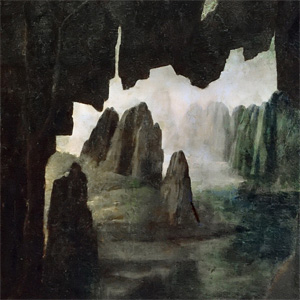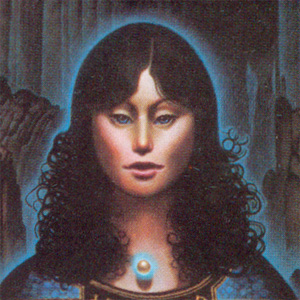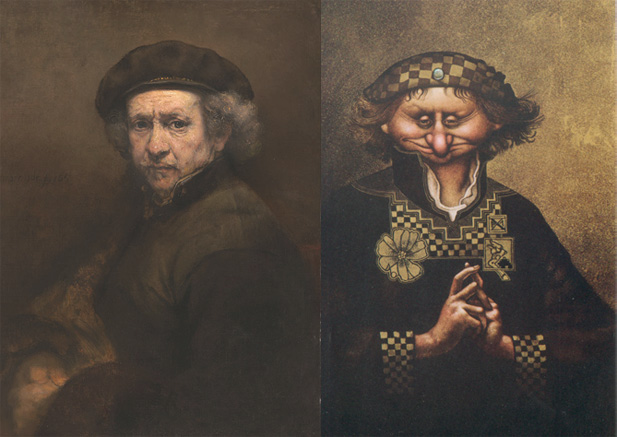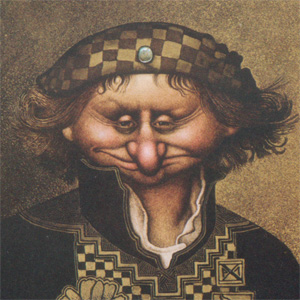The illustrations for The Secret were all painted by John Jude Palencar. From what we know, it appears that he didn't visit the treasure spots himself but used Polaroid photos taken by Byron Preiss to illustrate features of the area where each casque was hidden. Some of the features are large-scale, such as Milwaukee City Hall or the Statue of Liberty, while others show small, street-level details.
One feature is consistent across all of the images: the painting for each location includes the shape of a nearby shoreline. Presumably this is to emphasize the puzzle's theme of immigrants arriving by water. Most (but not all) of the shorelines have the "blue halo" effect to draw our attention. (Keep in mind that all of the shorelines are stylized. Palencar was more of an artist than a cartographer.)
| Image |
City |
Shoreline |
| 1 |
San Francisco |
The dress along the woman's right arm shows the California coastline from Santa Cruz to San Francisco. |
| 2 |
Charleston |
The pattern on the skull shows the Charleston peninsula, with Drum Island beside it. |
| 3 |
Roanoke Island |
The underside of the knight's right hand is a really clever reflected representation of the North Carolina coastline. The strange hook hanging from the knight's right wrist represents Albemarle Sound and the bent fingers represent estuaries for the Neuse, Pamlico, and Pungo rivers. |
| 4 |
Cleveland |
The tree branches (or roots) to the left of the monument form the approximate outline of Ohio, with the shoreline of Lake Erie at the top. |
| 5 |
Chicago |
The middle-left of the image shows the reversed outline of the state of Illinois, with Lake Michigan at the northeast corner. |
| 6 |
St. Augustine |
The entire negative space beside the rock shows the Florida coastline, and - more specifically - the pattern on the white rock shows the various peninsulas where the Matanzas River reaches the Atlantic. |
| 7 |
New Orleans |
The curves of the sleeve represent the bends in the Mississippi where it flows through the city. |
| 8 | Houston | Ridiculously enough, the rhino's head on the pillar shows the outline of Galveston Bay. The horn represents the Trinity River estuary and the shapes at the top of the pillar show the shoreline where Trinity Bay meets Galveston Bay between League City and Texas City. |
| 9 | Montreal | The right side of the white shirt collar forms the shape of the St. Lawrence River, as it flows northeast through Montreal. |
| 10 | Milwaukee | The bottom edge of the man's cape shows the shoreline of Lake Michigan near Milwaukee. |
| 11 | Boston | The shapes formed by the ends of the woman's hair show Boston Harbor, with piers that extend into the water. |
| 12 | New York | A shoreline along New York harbor is shown in the woman's dress. |
Some of the other general themes and repeated elements used in the illustrations include the following:
- birth stones (all images)
- birth flowers (all images)
- stars and moons (Images 1, 3, 7, 8, & 11)
- keys (Images 3 & 10)
- stylized outlines of states (Images 4, 5, & 6), islands (Images 2, 3, & 12), gardens (Images 8 & 11) or parks (Image 1)
- spheres and circles
- checkerboard patterns (Images 1, 7, & 9)
- other geometric shapes (straight lines, squares, triangles)
- mysterious symbols
- the numbers 1 through 12
- Roman numerals
- clocks and watches
- cryptic hand signals (Images 1, 3, 7, 9, & 12)
- blue halos or glows (possibly signaling water or indicating that some figure is important)
- a special emphasis on wrists, noses, and eyes
- references to dragons and St. George who killed the dragon
Preiss appears to have been a fan of public art, and several of the paintings incorporate small representations of distinctive artworks to help us identify the correct city. Some of these include:
- Image 5, The Bowman and Fountain of the Great Lakes (Chicago, IL)
- Image 8, The Armillary Sphere, The Atropos Key, and The Spirit of the Confederacy (Houston, TX)
- Image 10, Laureate (Milwaukee, WI)
- Image 12, The Statue of Liberty (New York, NY)
Evidence suggests that each of the 12 illustrations is based on a painting by a famous artist. That would explain the wildly differing styles of the artwork. So far, we only have two strong connections of this kind, but further research may turn up more matches. Here are the connections we've found:
Image 1 - Virgin of the Rocks by Leonardo da Vinci
|
Image 1 appears to be a visual reference to Virgin of the Rocks, which was painted by Leonardo da Vinci between 1483 and 1486.
Each of the two paintings is framed around a central woman wearing dark, flowing robes who stands before a small mountain of rocks. Both paintings have similar structures, with rounded tops that echo the rounded rock structures of the background. |
 |
|
| Both paintings feature gaps in the background rocks that allow the color of the sky to show through. The left-hand gap in each painting has a large open space flanked by narrow crevices. A hanging rock in the upper right of each gap creates a narrow crack that points upwards, while a standing pillar of rock in the lower left of each gap forms a tapering crack that points downwards. |
 |
 |
| The corresponding gap on the right side of each painting frames a single, standing column of rock. |
 |
 |
| Both woman have hair that is initially straight and flat (parted in the middle) but becomes curly below the ears. Both wear jewels prominently featured at their necklines. |
 |
 |
Image 9 - Self-Portrait with Beret and Turned-Up Collar by Rembrandt
|
Image 9 appears to be a visual reference to Self-Portrait with Beret and Turned-Up Collar, which was painted by Rembrandt in 1659.
Each painting shows a single individual seated before a flat, golden-brown background that only varies in subtle degrees of light. Each subject is wearing dark robes that tend to fade into the background and is seated with clasped hands, looking directly at the viewer. |
 |
|
| The figure in each portrait is wearing a beret that crosses the forehead in a broad arch. Graying, curly hair protrudes from under the beret on each side, partially covering each subject's ears. |
 |
 |
| The tunic worn by each subject has a high, dark collar marked by a line of gold along the margin. The collar presses into the figure's cheek, from ear to chin, before plunging down to leave an open neckline. |
 |
 |